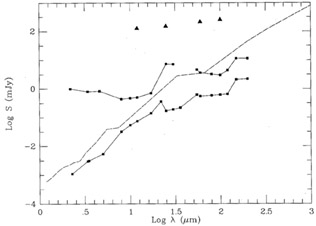


Where do we go next to test these ideas? Obviously we anxiously await the
revised, foreground-subtracted, DIRBE limits: if the team is able to
reliably subtract the
foregrounds to levels approaching the design sensitivity of
 I
I = 10-13 W cm-2 sr-1
(Boggess et al. 1992),
which is about 1% of the foreground emissions, then they can
expect to detect or rule out most of the predicted contributions to the
background by
evolving galaxies and infrared-bright protogalaxies shown in
Figures 4,
5,
6 and
8.
= 10-13 W cm-2 sr-1
(Boggess et al. 1992),
which is about 1% of the foreground emissions, then they can
expect to detect or rule out most of the predicted contributions to the
background by
evolving galaxies and infrared-bright protogalaxies shown in
Figures 4,
5,
6 and
8.
Although the nineties was heralded as the decade of the infrared by the Bahcall committee, the poor funding situation at present has delayed our hopes for the next generation US infrared mission, SIRTF, into the next century. Meanwhile the European satellite ISO is due to launch in late 1995. Both ISO and SIRTF are observatory class instruments, differing from the survey instruments IRAS and COBE in having small beams and fields-of-view. Thus they are optimized for point source work and fluctuation analyses much more than direct background measurements, although SIRTF may be able to match the surface brightness sensitivity of DIRBE with considerable work. SIRTF will be especially important for cosmological studies because its detector technology will be frozen at a much later date than that of ISO, and because it has larger arrays than ISO. Figure 10 compares the expected point source sensitivities of ISO and SIRTF compared to IRAS F10214+4724 removed to z = 10.

|
Figure 10. ISO and SIRTF background-limited
point source sensitivities, 5 |
SIRTF may hope to resolve all of any background that DIRBE may detect in
the near-infrared window near 3µm. A calculation by
E. Wright (M. Werner, private
communication) shows that the minimum expected integrated intensity at
3.5µm due
to galaxies is about
 I
I = 3.4 x 10-13 W/cm2/sr. This is
derived from the measured
extragalactic number counts at 2.2µm
(Gardner et
al. 1993),
assuming a temperature
of 2000K to estimate the 2.2µm-3.5µm
color. Comparing this to the hoped-for ultimate
DIRBE sensitivity of about 10-13 W/cm2/sr it is
clear that the background due to this
known population will be detected by DIRBE. At an intensity of 3.4 x
10-13 W/cm2/sr,
the number of faint galaxies per 0.7 degree DIRBE beam is about 1.2 >
105, giving an
average separation of 10 arcsec. This is within reach of the 1 arcsec
beam of SIRTF to
resolve. To reach the required limit of 21.6 mag. at 3.5µm
with SIRTF will require an
integration time of about 10,000 seconds.
= 3.4 x 10-13 W/cm2/sr. This is
derived from the measured
extragalactic number counts at 2.2µm
(Gardner et
al. 1993),
assuming a temperature
of 2000K to estimate the 2.2µm-3.5µm
color. Comparing this to the hoped-for ultimate
DIRBE sensitivity of about 10-13 W/cm2/sr it is
clear that the background due to this
known population will be detected by DIRBE. At an intensity of 3.4 x
10-13 W/cm2/sr,
the number of faint galaxies per 0.7 degree DIRBE beam is about 1.2 >
105, giving an
average separation of 10 arcsec. This is within reach of the 1 arcsec
beam of SIRTF to
resolve. To reach the required limit of 21.6 mag. at 3.5µm
with SIRTF will require an
integration time of about 10,000 seconds.
A similar calculation at 60µm based on a local
60µm luminosity function and
exponential evolution with
 = 1.5, H0 = 75,
indicates that about 60% of the predicted
background above an anticipated DIRBE limit of about 2 x
10-13 W cm-2 sr-1 will
be resolvable by SIRTF, assuming a SIRTF confusion limit of about 0.1
mJy at this wavelength
(Wright et al. 1993).
= 1.5, H0 = 75,
indicates that about 60% of the predicted
background above an anticipated DIRBE limit of about 2 x
10-13 W cm-2 sr-1 will
be resolvable by SIRTF, assuming a SIRTF confusion limit of about 0.1
mJy at this wavelength
(Wright et al. 1993).
Franceschini et
al. (1991)
have calculated the fluctuations expected in the 0.7 degree
DIRBE beam due to their model evolving galaxy populations. Fluctuations
 I
I /
I
/
I range from 2% at 280µm, through 4-7% at 25 to
100µm and rise to 50% at 2.2µm.
These high values at short wavelengths are dominated by bright stars in
the galaxy.
The main limitation at the longer wavelengths will be confusion noise
due to galactic cirrus emission
(Gautier et
al. 1992).
range from 2% at 280µm, through 4-7% at 25 to
100µm and rise to 50% at 2.2µm.
These high values at short wavelengths are dominated by bright stars in
the galaxy.
The main limitation at the longer wavelengths will be confusion noise
due to galactic cirrus emission
(Gautier et
al. 1992).